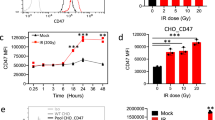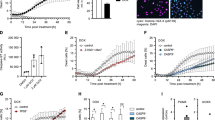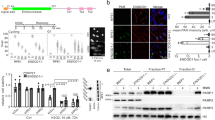Abstract
Some stimulatory receptors of the innate immune system, such as the NKG2D receptor (also called KLRK1) expressed by natural killer cells and activated CD8+T cells, recognize self-molecules that are upregulated in diseased cells by poorly understood mechanisms1. Here we show that mouse and human NKG2D ligands are upregulated in non-tumour cell lines by genotoxic stress and stalled DNA replication, conditions known to activate a major DNA damage checkpoint pathway initiated by ATM (ataxia telangiectasia, mutated) or ATR (ATM- and Rad3-related) protein kinases2. Ligand upregulation was prevented by pharmacological or genetic inhibition of ATR, ATM or Chk1 (a downstream transducer kinase in the pathway). Furthermore, constitutive ligand expression by a tumour cell line was inhibited by targeting short interfering RNA to ATM, suggesting that ligand expression in established tumour cells, which often harbour genomic irregularities, may be due to chronic activation of the DNA damage response pathway. Thus, the DNA damage response, previously shown to arrest the cell cycle and enhance DNA repair functions, or to trigger apoptosis, may also participate in alerting the immune system to the presence of potentially dangerous cells.
This is a preview of subscription content, access via your institution
Access options
Subscribe to this journal
Receive 51 print issues and online access
$199.00 per year
only $3.90 per issue
Buy this article
- Purchase on Springer Link
- Instant access to full article PDF
Prices may be subject to local taxes which are calculated during checkout





Similar content being viewed by others
References
Raulet, D. H. Roles of the NKG2D immunoreceptor and its ligands. Nature Rev. Immunol. 3, 781–790 (2003)
Abraham, R. T. Cell cycle checkpoint signalling through the ATM and ATR kinases. Genes Dev. 15, 2177–2196 (2001)
Xing, D. & Orsulic, S. A genetically defined mouse ovarian carcinoma model for the molecular characterization of pathway-targeted therapy and tumour resistance. Proc. Natl Acad. Sci. USA 102, 6936–6941 (2005)
Bakkenist, C. J. & Kastan, M. B. DNA damage activates ATM through intermolecular autophosphorylation and dimer dissociation. Nature 421, 499–506 (2003)
Osborn, A. J., Elledge, S. J. & Zou, L. Checking on the fork: the DNA-replication stress-response pathway. Trends Cell Biol. 12, 509–516 (2002)
Sancar, A., Lindsey-Boltz, L. A., Unsal-Kaccmaz, K. & Linn, S. Molecular mechanisms of mammalian DNA repair and the DNA damage checkpoints. Annu. Rev. Biochem. 73, 39–85 (2004)
Sarkaria, J. N. et al. Inhibition of ATM and ATR kinase activities by the radiosensitizing agent, caffeine. Cancer Res. 59, 4375–4382 (1999)
Brown, E. J. & Baltimore, D. Essential and dispensable roles of ATR in cell cycle arrest and genome maintenance. Genes Dev. 17, 615–628 (2003)
Nyberg, K. A., Michelson, R. J., Putnam, C. W. & Weinert, T. A. Toward maintaining the genome: DNA damage and replication checkpoints. Annu. Rev. Genet. 36, 617–656 (2002)
Weitzman, M. D., Carson, C. T., Schwartz, R. A. & Lilley, C. E. Interactions of viruses with the cellular DNA repair machinery. DNA Repair (Amst.) 3, 1165–1173 (2004)
Lodoen, M. et al. NKG2D-mediated natural killer cell protection against cytomegalovirus is impaired by viral gp40 modulation of retinoic acid early inducible 1 gene molecules. J. Exp. Med. 197, 1245–1253 (2003)
Bartek, J. & Lukas, J. Chk1 and Chk2 kinases in checkpoint control and cancer. Cancer Cell 3, 421–429 (2003)
Mills, K. D., Ferguson, D. O. & Alt, F. W. The role of DNA breaks in genomic instability and tumorigenesis. Immunol. Rev. 194, 77–95 (2003)
Sieber, O. M., Heinimann, K. & Tomlinson, I. P. Genomic instability–the engine of tumorigenesis? Nature Rev. Cancer 3, 701–708 (2003)
Gorgoulis, V. G. et al. Activation of the DNA damage checkpoint and genomic instability in human precancerous lesions. Nature 434, 907–913 (2005)
Bartkova, J. et al. DNA damage response as a candidate anti-cancer barrier in early human tumorigenesis. Nature 434, 864–870 (2005)
Gonzalez, S., Prives, C. & Cordon-Cardo, C. p73alpha regulation by Chk1 in response to DNA damage. Mol. Cell. Biol. 23, 8161–8171 (2003)
Bignami, M., Casorelli, I. & Karran, P. Mismatch repair and response to DNA-damaging antitumour therapies. Eur. J. Cancer 39, 2142–2149 (2003)
Zhou, B. B. & Bartek, J. Targeting the checkpoint kinases: chemosensitization versus chemoprotection. Nature Rev. Cancer 4, 216–225 (2004)
Jamieson, A. M. et al. The role of the NKG2D immunoreceptor in immune cell activation and natural killing. Immunity 17, 19–29 (2002)
Brown, E. J. & Baltimore, D. ATR disruption leads to chromosomal fragmentation and early embryonic lethality. Genes Dev. 14, 397–402 (2000)
Lander, M. R., Moll, B. & Rowe, W. P. A procedure for culture of cells from mouse tail biopsies: brief communication. J. Natl Cancer Inst. 60, 477–478 (1978)
Diefenbach, A., Jamieson, A. M., Liu, S. D., Shastri, N. & Raulet, D. H. Ligands for the murine NKG2D receptor: expression by tumour cells and activation of NK cells and macrophages. Nature Immunol. 1, 119–126 (2000)
Diefenbach, A., Hsia, J. K., Hsiung, M. Y. & Raulet, D. H. A novel ligand for the NKG2D receptor activates NK cells and macrophages and induces tumour immunity. Eur. J. Immunol. 33, 381–391 (2003)
Krause, D. R. et al. Suppression of Tousled-like kinase activity after DNA damage or replication block requires ATM, NBS1 and Chk1. Oncogene 22, 5927–5937 (2003)
Zhang, X. et al. Artemis is a phosphorylation target of ATM and ATR and is involved in the G2/M DNA damage checkpoint response. Mol. Cell. Biol. 24, 9207–9220 (2004)
Hernandez-Hoyos, G., Anderson, M. K., Wang, C., Rothenberg, E. V. & Alberola-Ila, J. GATA-3 expression is controlled by TCR signals and regulates CD4/CD8 differentiation. Immunity 19, 83–94 (2003)
Acknowledgements
We thank J. Thorner and S. Linn for discussions; Y. Natanzon and L. Zhang for technical assistance; H. Nolla for assistance with flow cytometry; and L. Fritz-Laylin for help with transductions. This work was supported by a National Institutes of Health grant to D.H.R. and an award from the Prostate Cancer Foundation.
Author information
Authors and Affiliations
Corresponding author
Ethics declarations
Competing interests
Reprints and permissions information is available at npg.nature.com/reprintsandpermissions. The authors declare no competing financial interests.
Supplementary information
Supplementary Figure S1
Specific induction of NKG2D ligands by treatments that activate the DNA damage response. (PDF 692 kb)
Supplementary Figure S2
Real time RT-PCR quantitation of Rae1 and MULT1 transcript levels in cell lines treated with aphidicolin. (PDF 483 kb)
Supplementary Figure S3
Cell cycle status of ATR-deleted fibroblasts. (PPT 141 kb)
Supplementary Figure S4
ATR/ATM inhibitors prevent NKG2D ligand upregulation. (PPT 319 kb)
Rights and permissions
About this article
Cite this article
Gasser, S., Orsulic, S., Brown, E. et al. The DNA damage pathway regulates innate immune system ligands of the NKG2D receptor. Nature 436, 1186–1190 (2005). https://doi.org/10.1038/nature03884
Received:
Accepted:
Published:
Issue Date:
DOI: https://doi.org/10.1038/nature03884
This article is cited by
-
Natural killer cell therapies
Nature (2024)
-
KLF4-mediated upregulation of the NKG2D ligand MICA in acute myeloid leukemia: a novel therapeutic target identified by enChIP
Cell Communication and Signaling (2023)
-
Local γδ T cells: translating promise to practice in cancer immunotherapy
British Journal of Cancer (2023)
-
The DNA damage response pathway regulates the expression of the immune checkpoint CD47
Communications Biology (2023)
-
Roles of natural killer cells in immunity to cancer, and applications to immunotherapy
Nature Reviews Immunology (2023)
Comments
By submitting a comment you agree to abide by our Terms and Community Guidelines. If you find something abusive or that does not comply with our terms or guidelines please flag it as inappropriate.



